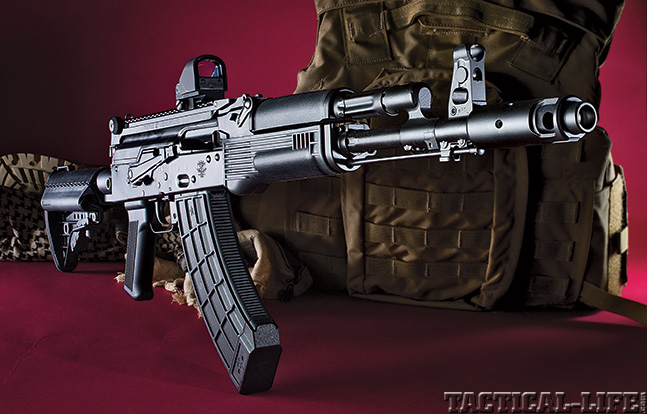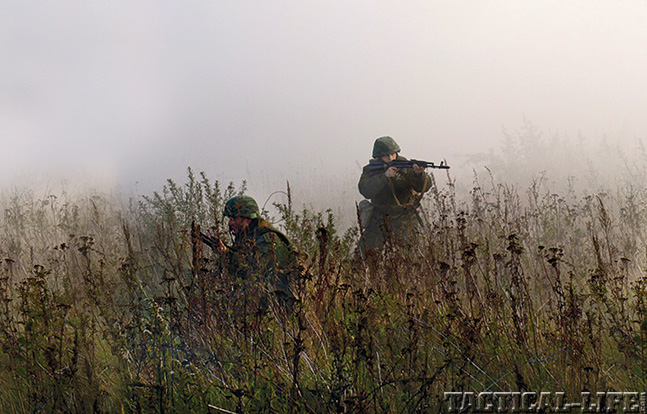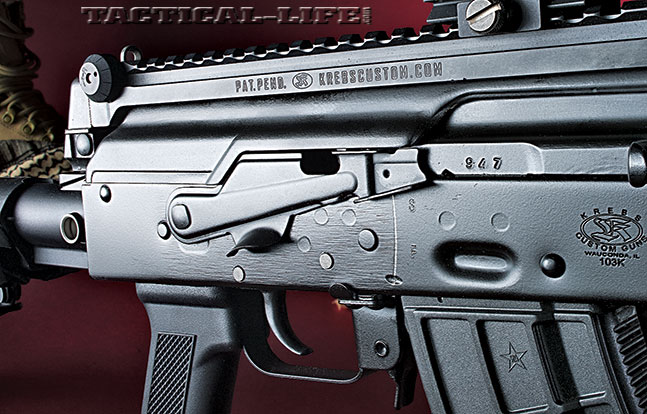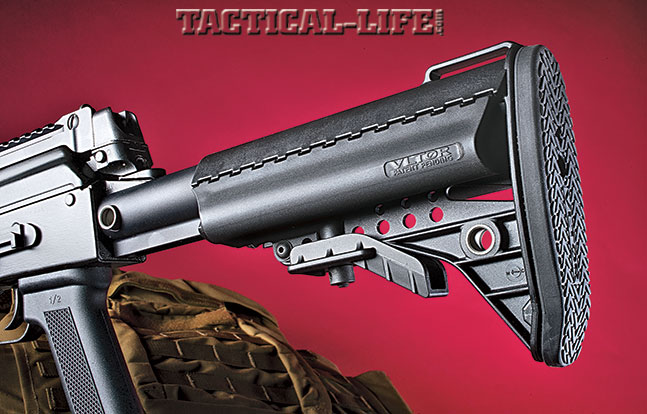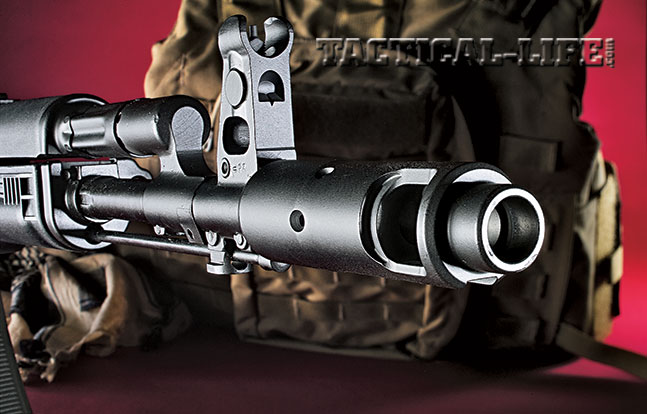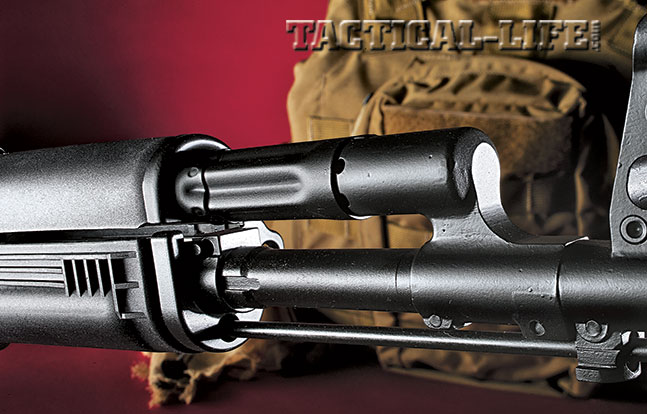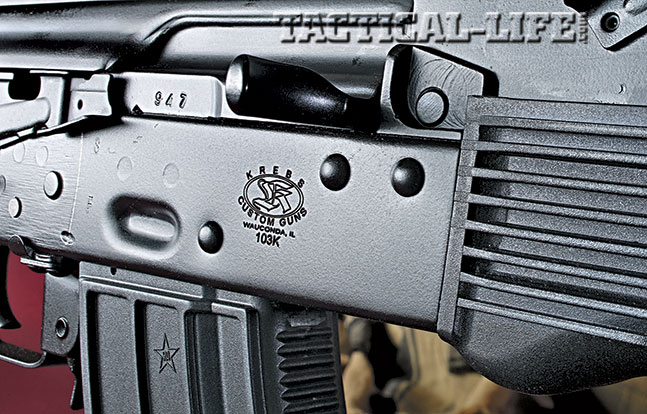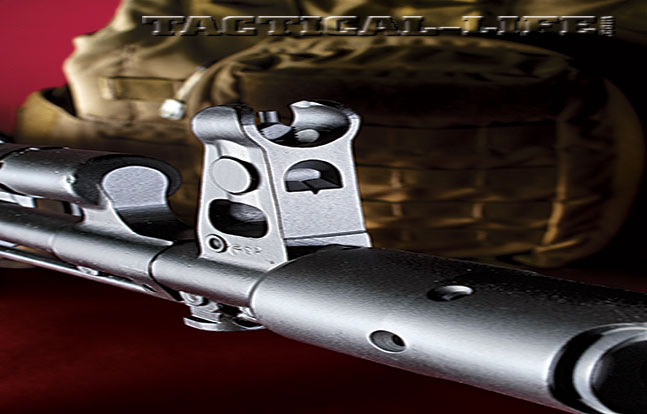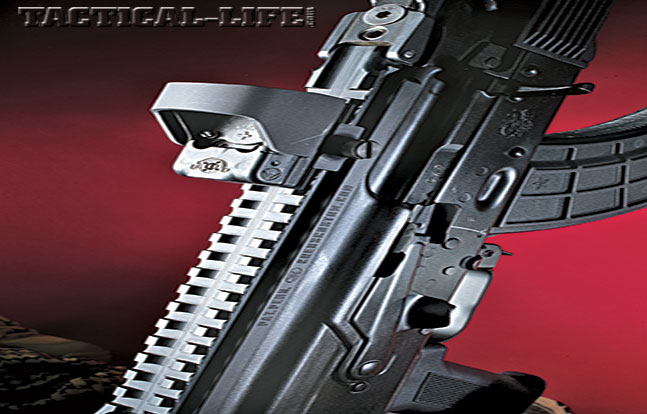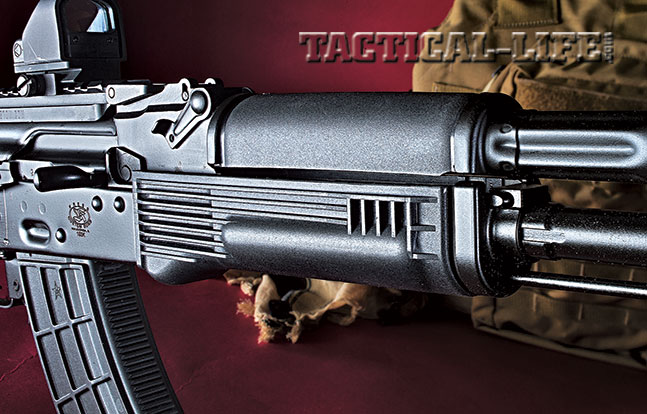I may not be first in line to purchase a Russian-made car or TV, but when it comes to firearms, Russia certainly has a long warrior tradition that values highly effective arms, and it’s possible that there is no firearm this is more true of than the AK. When it comes to real Russian AKs, there is one place that comes to mind immediately for Kalashnikov enthusiasts: Izhmash Arms Factory, which was originally founded over 200 years ago by Czar Alexander I. Located in Izhevsk, deep within the Western Urals and almost 500 miles east of Moscow, Izhmash was Mikhail Kalashnikov’s workplace for 60 years, beginning shortly after World War II.
RELATED: Krebs Custom Speed Load Tactical Rifle
The AK rifles produced by Izhmash are imported to the U.S. as sporting rifles under the Saiga name. That means you get a very plain-looking polymer buttstock, no protruding pistol grip, a trigger and triggerguard moved far to the rear of the receiver, and an elongated handguard. But, you also get a rifle made to original military specs in the same factory that makes Russian military arms, by the same people. Several domestic manufacturers do a brisk business of legally converting these AKs back to their original configuration by adding the requisite number of U.S. parts. However, for me there is no manufacturer that does a better job of working on Saiga AKs than Krebs Custom.
Advertisement — Continue Reading Below
Gun Details
The Krebs AK-103K may start as a Russian AK, but the addition of American ingenuity in my opinion makes it better than the original. Krebs starts out with a rock-solid reliable, semi-automatic, rotary-bolt, long-stroke-gas-piston-operated rifle complete with a hammer-forged, chrome-lined barrel chambered in traditional 7.62x39mm. On the AK-103K model tested, Krebs cut the barrel down to 14 inches and then added a permanently attached muzzle brake to bring the legal barrel length to 16.5 inches. The brake itself is made by Krebs and modeled on the original Russian brake for the AK-74 rifle. Unlike the old slant-style brake, which simply direct gasses upwards to offset muzzle rise, this brake uses a two-chambered system that actively reduces felt recoil.
RELATED: Running Red: 20 Top AK-47s & Soviet Weapons
Advertisement — Continue Reading Below
Three ports located at the back of the brake direct gasses upward and to the right to counter muzzle rise. In addition, the front of the muzzle brake features a distinct open split. Slots at the front of the chamber direct gasses backward, pushing the rifle forward and also reducing felt recoil. The final result of all of this is a brake that keeps the rifle on target for faster follow-up shots, noticeably reducing perceived recoil to the point that the 7.62x39mm cartridge feels closer to a 5.56x45mm—and there is very little muzzle flash. Underneath the barrel are an original bayonet lug and steel cleaning rod.
The gas block itself is also of the AK-74 variety and features a distinct 90-degree angle instead of the old, more slanted look of the original AK-47. When the Soviets switched from the standard 7.62x39mm cartridge to the new smaller diameter 5.45x39mm cartridge, the size and angle of the gas hole in the barrel reportedly caused some incidents of bullet shear. This resulted in bullet shavings entering the gas system and degrading the operation, while the damaged bullet had reduced accuracy. The 90-degree gas block presented a smaller opening and resolved this issue and has been applied to a variety of new-production Kalashnikov rifles.
Like all AK-pattern rifles, the Krebs AK-103K uses a long-stroke gas-piston system of operation. The gasses bled from the barrel directly impact a long, chrome-plated, steel piston that is permanently affixed to the bolt carrier and charging handle. This carries the rotating bolt, which features two locking lugs on its face. When firing, the operating rod, handle and unlocked bolt move back as one unit, improving the rifle’s reliability in field conditions. This is nevertheless a lot of mass slamming back and forth, which can increase perceived recoil, shift point of aim and affect accuracy. Indeed, AKs are not generally admired for their accuracy, although they can be capable of achieving very good results in this regard. The effect of this system on reliability is undeniable, however, and this is one of the AK’s key strengths. The fixed charging handle does reciprocate when firing (so some attention needs to be paid to weapon position), but it also makes a very effective forward assist and helps greatly if you need to remove a stuck round.
Advertisement — Continue Reading Below
Krebs takes this already reliable system and improves it by smoothing the action, dehorning the edges inside and out, and adding a tuned U.S. trigger and safety selector. The Krebs custom safety selector, made from a single 1mm-thick piece of stamped steel, is indeed worthy of mention and a drastic improvement over the standard Russian selector. The new right-side-mounted safety selector features a cutout that serves as a manually activated bolt hold-open device. Normally, AK selectors have an extension at the front to operate them and require the user to remove his or her hand from the pistol grip to do so. But the Krebs Custom selector adds an extended tab at the rear bottom of the selector, which allows the shooter (if right-handed) to use the trigger finger to operate it without having to remove the hand from the pistol grip. This makes operation of the rifle by the user much easier.
The handguard and pistol grip are standard, U.S.-made, black polymer parts. They are well executed and attractive while remaining true to the dimensions of the original. The buttstock, however, has been replaced with a complete unit from VLTOR that is specifically made for a stamped-receiver AK. An AR-style, aluminum receiver-extension tube allows for the use of any mil-spec collapsible stock. The receiver tube is very well built and sturdy.
The VLTOR receiver extension tube offers five levels of adjustment for length of pull, and the numbers are clearly marked on top, so it is easy for the operator to return to a desired position. The tube also has ambidextrous single-point sling attachment mounts at the front and a sizable waterproof internal storage space, which is easily accessed from the rear by removing the buttstock. The black polymer stock itself is the VLTOR IMod (improved modstock), which features its own battery storage spaces and ambidextrous single-point sling attachment mounts, as well as a sling mount on top. The buttpad has a thick rubber covering with a tire-track pattern for improved shoulder retention.
Advertisement — Continue Reading Below
One common criticism of the AK design is that it does not lend itself to easy mounting of optics. Mounting a length of rail to the top receiver cover is simply not stable enough to hold zero for serious shooting. The Russians added a much sturdier optics mount to the left side of the receiver itself, but this often leaves the optic slightly offset and mounted too high for a comfortable cheekweld. Krebs Custom resolves this with the addition of its outstanding rear-sight receiver rail system. This rail rides as low as possible over the receiver cover, without replacing it. It attaches solidly at the rear sight base and the buttstock tang. This solid, anodized 7075 aluminum system provides 8 inches of Picatinny rail for attaching optics.
At the rear of the system is an AR-style peep sight with a small and large flip aperture that can be adjusted for elevation, as well as an AR-style windage adjustment knob. These iron sights are not only a huge improvement over the standard AK sights but also address another criticism of the AK: the short sight radius. The Krebs system extends the sight radius all the way to the rear of the receiver, a 60 percent improvement that increases the rifle’s accuracy potential. This system also allows for easy disassembly with an AR-style takedown pin at the rear, which allows the entire rail to rotate up for removal of the receiver cover. Standard AK disassembly is then possible for routine maintenance.
The fit and finish of the Krebs Custom AK-103K is flawless. Krebs has taken the standard Russian finish and replaced it with its KrebsKote solvent-proof finish. The end result is the best I have seen on an AK.
Advertisement — Continue Reading Below
Range Time
At the range the AK-103K performed flawlessly with zero malfunctions of any sort and was extremely comfortable to shoot. The AK-74-style muzzle brake significantly reduced the rifle’s already light recoil, and the tuned trigger was very smooth with a 4.5-pound pull. This is still a standard AK-type single-stage trigger with a long degree of travel, which can make it difficult to tell when it will break, but it is still far better than most AK triggers I have used.
For accuracy testing I installed the Millet DMS scope with a quickly adjustable variable 1-4×24 illuminated reticle for low-light use, This scope is excellent both as a CQB sight and for engaging targets at distances out to 500 yards. The reticle has a simple 1-MOA dot surrounded by an 18-MOA donut, which can be used for range estimation. From a benchrest at 100 yards and using a mix of ammunition, the AK-103K performed very well, producing consistent 2- to 3-MOA results with several groups measuring under 2 MOA. This is excellent accuracy for a combat rifle.
Advertisement — Continue Reading Below
AK fans have a lot of options and variety available to them today, considering all the different nations that have produced this classic rifle. But Marc Krebs of Krebs Custom really does stand out. Krebs cut his teeth as a gunsmith under the tutelage of master gunsmith Bob Dunlap and began building custom 1911s before venturing into military rifles. I for one am certainly glad that his interests settled on the AK, where in my opinion his innovation and custom work has produced one of the best AK variants available today.
For more information, visit krebscustom.com or call 847-487-7776.
